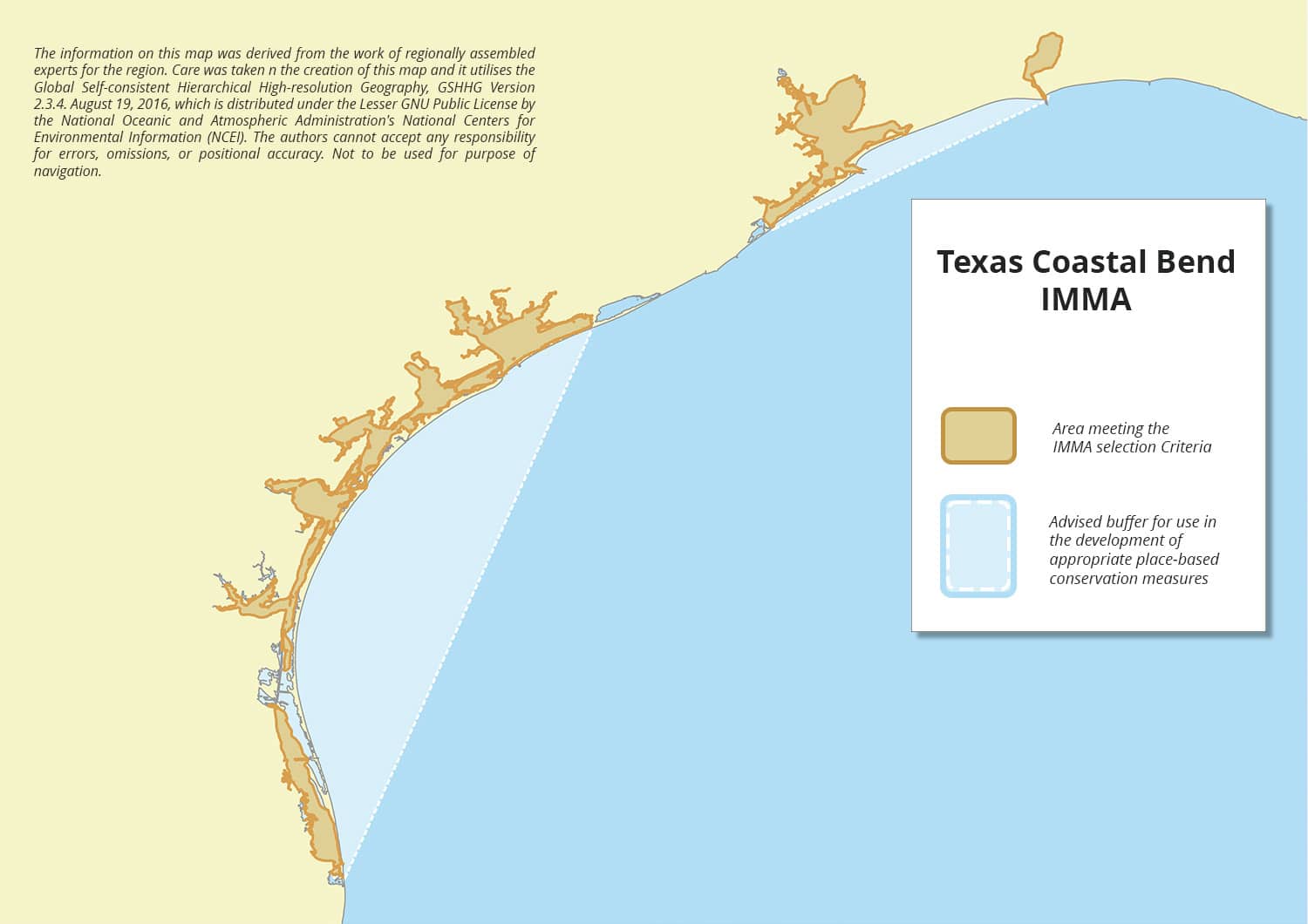Texas Coastal Bend IMMA
Size in Square Kilometres
5 475 km2
Qualifying Species and Criteria
Common bottlenose dolphin – Tursiops truncatus
Criterion B (2)
Download fact sheet
Summary
The Texas Coastal Bend IMMA encompasses bays and estuaries along the northern Gulf of Mexico from Port Isabel in the south to Corpus Christi Bay, Aransas and Copano Bay, St. Antonio bay, Matagorda, Galveston bay and Sabine lake in the north. The IMMA extends to the 5m contour line offshore. These bays and estuaries, which include seagrass meadows and mangrove channels host high densities of common bottlenose dolphins (Tursiops truncatus), some of which form small resident populations, but many of which are non-resident and known to roam more widely, with resident and non-resident populations frequently mixing.
Description of Qualifying Criteria
Criterion B: Distribution and Abundance
Sub-criterion B1: Small and Resident Populations
Long-term photo identification studies in multiple sites within the IMMA indicate that there are resident populations of common bottlenose dolphins (Tursiops truncatus) (from south to north) in the Matagorda-Espiritu Santo Bay area (Gruber 1981; Lynn and Würsig 2002), Aransas Pass (Shane 1977; Weller 1998), San Luis Pass (Maze and Würsig 1999; Irwin and Würsig 2004), and Galveston Bay (Bräger 1993; Bräger et al. 1994; Fertl 1994; Fazioli and Mintzer 2020). However, mixing of residents and non-residents is known to occur, at least in San Luis Pass (Maze and Würsig, 1999). Most dolphins in the mouths of Galveston Bay and Port Aransas, for example, are considered transients (Weller, 1998).
Sub-criterion B2: Aggregations
At least seven discrete Bays, Sounds and Estuaries (BSE) stocks of common bottlenose dolphins recognized by NOAA Fisheries are included in this IMMA: Laguna Madre, Nueces Bay/Corpus Christi Bay, Copano Bay/Aransas Bay/San Antonio Bayt/Redfish Bay/Espiritu Bay, Matagorda Bay/Tres Palacios Bay/Lavaca Bay, West Bay, Galveston Bay/Trinity Bay, and Sabine Lake (NMFS, 2021). Bottlenose dolphins in these systems are very common, and the combined abundance for all stocks is probably several thousand individuals. The most recent abundance estimate for Galveston Bay, a stock that is considered transient, is 1,417 during the summer months (CV=0.13; 95% CI: 846-1,417) (Ronje et al., 2020).
Supporting Information
Bräger, S. 1993. Diurnal and seasonal behavior patterns of bottlenose dolphins (Tursiops truncatus). Marine Mammal Science 9(4):434–440.
Bräger, S., B. Würsig, A. Acevedo and T. Henningsen. 1994. Association patterns of bottlenose dolphins (Tursiops truncatus) in Galveston Bay, Texas. Journal of Mammalogy 75(2):431–437.
Fazioli, K. and V. Mintzer. 2020. Short-term effects of Hurricane Harvey on bottlenose dolphins (Tursiops truncatus) in Upper Galveston Bay, TX. Estuaries and Coasts 43:1013–1031.
Fertl, D.C. 1994. Occurrence patterns and behavior of bottlenose dolphins (Tursiops truncatus) in the Galveston ship channel. Texas Journal of Science 46:299–317.
Gruber, J.A. 1981. Ecology of the Atlantic bottlenosed dolphin (Tursiops truncatus) in the Pass Cavallo area of Matagorda Bay, Texas. M.Sc. Thesis from Texas A&M University, College Station. 182pp.
Irwine, L.J. and B. Würsig. 2004. A small resident community of bottlenose dolphins, Tursiops truncatus, in Texas: Monitoring recommendations. Gulf of Mexico Science 22(1):13–21.
Lynn, S.K. and B. Würsig. 2002. Summer movement patterns of bottlenose dolphins in a Texas bay. Gulf of Mexico Science 20(1):25–37.
Maze, K.S. and B. Würsig. 1999. Bottlenose dolphins of San Luis Pass, Texas: Occurrence patterns, site fidelity, and habitat use. Aquatic Mammals 25(2):91–103.
National Marine Fisheries Service, 2021. Common Bottlenose Dolphin (Tursiops truncatus truncatus): Northern Gulf of Mexico Bay, Sound, and Estuary Stocks. Marine Mammal Stock Assessment Reports by Species/Stock. https://www.fisheries.noaa.gov/s3/2023-08/Common-Bottlenose-Dolphin-Northern-Gulf-of-Mexico-Bay-Sound-and-Estuary-2022.pdf
Ronje, E.I., H.R. Whitehead, K. Barry, S. Piwetz, J. Struve, V. Lecours, L.P. Garrison, R.S. Wells and K.D. Mullin. 2020. Abundance and occurrence of common bottlenose dolphins (Tursiops truncatus) in three estuaries of the northwestern Gulf of Mexico. Gulf and Caribbean Research 31:18–34.
Shane, S.H. 1977. The population biology of the Atlantic bottlenose dolphin, Tursiops truncatus, in the Aransas Pass area of Texas. M.Sc. Thesis from Texas A&M University, College Station. 238 pp.
Weller, D.W. 1998. Global and regional variation in the biology and behavior of bottlenose dolphins. Ph.D. Thesis from Texas A&M University, College Station. 142pp.
Downloads
Download the full account of the Texas Coastal Bend IMMA using the Fact Sheet button below:
To make a request to download the GIS Layer (shapefile) for the Texas Coastal Bend IMMA please complete the following Contact Form:


